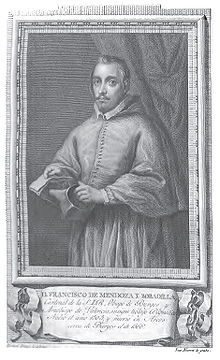User:Ishbiliyya/sandbox
 Cardinal Francisco de Mendoza y Bobadilla, author of the work. | |
| Author | Francisco Mendoza de Bobadilla |
|---|---|
| Language | Spanish |
| Genre | Genealogy, politics |
| Published | 20 August 1560 Archdiocese of Burgos |
| Publication place | Kingdom of Spain |
| republished 1885 and 1992 | |
El Tizón de la Nobleza Española, ó, máculas de los mas altos linajes (English: The Stain on the Spanish Nobility, or, Blots in the Highest Lineages) is a Spanish genealogical and political work published on 20 August 1560 by Cardinal Francisco Mendoza de Bobadilla, Archbishop of Burgos addressed to Philip II Habsburg, King of Spain. The book was authored as a critique of the limpieza de sangre (purity of blood) laws which barred Conversos (Jewish converts to Catholicism) from serving in high offices of state as well as from joining the prestigious chivalric Order of Santiago.
Cardinal Mendoza de Bobadilla was motivated to write the book after his nephew was excluded from a state office due to having some Converso ancestry. The book set out to demonstrate that the highest houses of the Spanish nobility; with a particular focus on that of the Crown of Castile; had either direct Converso, Morisco or even slave ancestry or close family members married to such people. The Cardinal thus saw such a stringent blood purity policy as a hypocrisy and farce.
A similar book, entitled El Libro Verde de Aragón had been authored in 1507, focusing on the Crown of Aragon; however, this was authored with the opposite intention, as an anti-Jewish and anti-aristocracy work by Juan de Anchias, an assessor of the Zaragoza Inquisition. During different time periods in Spanish history, these books have been suppressed by the Crown. El Tizón was republished by José Amador de los Rios in 1885 and again in 1992.
Genealogies
[edit]The families implicated by the Cardinal in El Tizón included the most high profile families outside of the Habsburg monarchy itself in the Kingdom of Spain, such as; Álvarez de Toledo (Duke of Alba, Duke of Huéscar, Count of Oropesa, etc), Pacheco (Duke of Escalona) and Portocarrero (Count of Montijo, Count of Medellín, Marquess of Villanueva del Fresno, etc).
Others listed as effected by this intermarriage included ducal families such as Pérez de Guzmán (Duke of Medina Sidonia), de la Cueva (Duke of Alburquerque), de Mendoza (Duke of the Infantado, Count of Mondéjar), Suárez de Figueroa (Duke of Feria) and de la Cerda (Duke of Medinaceli), countal families such as Pimentel (Count of Benavente), Abarca de Bolea (Count of Aranda), Fernández de Córdoba (Count of Alcaudete, Marquess of Villafranca, Marquess of Priego, Marquess of Comares, etc) and Fernández de Quiñones (Count of Luna) and marquessorial families such as Messía Carrillo (Marquess of La Guardia) and de Zúñiga (Marquess of Gibraleón, Marquess of Ayamonte, etc). These families have subsequently had offspring with many others.
The response to the book was a huge political and social scandal in Spain. The nobility were enraged by Cardinal Mendoza de Bobadilla, but attacking him proved difficult as he was a Prince of the Church, had the protection of the Holy Inquisition and furthermore the nobility could not show that what he said was libelous or false in any way. Eventually, the nobility were able to pressure the monarchy into invoking royal authority to suppress the book. However, it continued a life as a clandestine document, provoking rumour for a long time afterward.
Suppression
[edit]El Tizón and the similar Libro Verde continued to haunt the Spanish nobility and was sometimes used by commoners to argue that they had purer ancestry than the "aristocrats". Consequently, in 1624, Philip IV Habsburg, King of Spain commissioned the Inquisitor-General, Andreas Pacheco (himself descended from Marranos), to collect and destroy all copies of such books. A single 16th century copy of the Libro Verde survived and is preserved in the Biblioteca Colombina, Seville (this manuscript was copied by Demetrio de los Rios for his historian brother José Amador de los Rios and was published in 1885, but was soon censored too). El Tizón was reprinted in 1992 by the Colegio Heraldico de Espana y de las Indias.
See also
[edit]- Count of Chinchón — Mendoza de Bobadilla's relatives
- Marrano — Converts who secretly continued to practice Judaism
- Hidalgo (nobility) — members of the Spanish or Portuguese nobility
- Passing (racial identity) — ethnic classification in societies
- Paul of Burgos — prominent Converso with many noble descendants
- Alumbrados — heterodox Spanish group opposed by Inquisition
References
[edit]Footnotes
[edit]Bibliography
[edit]- The Spanish Inquisition: A Historical Revision by Henry Kamen
- Genealogical Fictions: Limpieza de Sangre, Religion, and Gender in Colonial Mexico by María Elena Martínez
- The Anxiety of Sameness in Early Modern Spain by Christina H. Lee
- The Jesuit Order As a Synagogue of Jews: Jesuits of Jewish Ancestry by Robert A. Maryks
- Los judíos en la España moderna y contemporánea by Julio Caro Baroja
- The Libro Verde: Blood Fictions from Early Modern Spain by John Beusterien
- Los judaizantes castellanos y la Inquisicion en tiempo de Isabel la Catolica by Nicolás López Martínez
- Historia de los Judios en España by José Amador de los Rios
- Los hispano-hebreos conversos en la genealogía y nobiliaria de España "El libro verde de Aragón" y "El tizón de la nobleza de España" by Rafael de Gil Gomez
- Noble Families Among the Sephardic Jews by Isaäc da Costa
External links
[edit]- El Tizón de la Nobleza Española
- Memoria de Sefarad
- Juan de Anchias by Jewish Encyclopedia
- El Libro Verde de Aragón at Sefarad.org
- Shields of Grace by Roger Louis Martínez-Dávila
Category:1560 books Category:History of the conversos Category:Jewish genealogy Category:Spanish nobility Category:Spanish books
